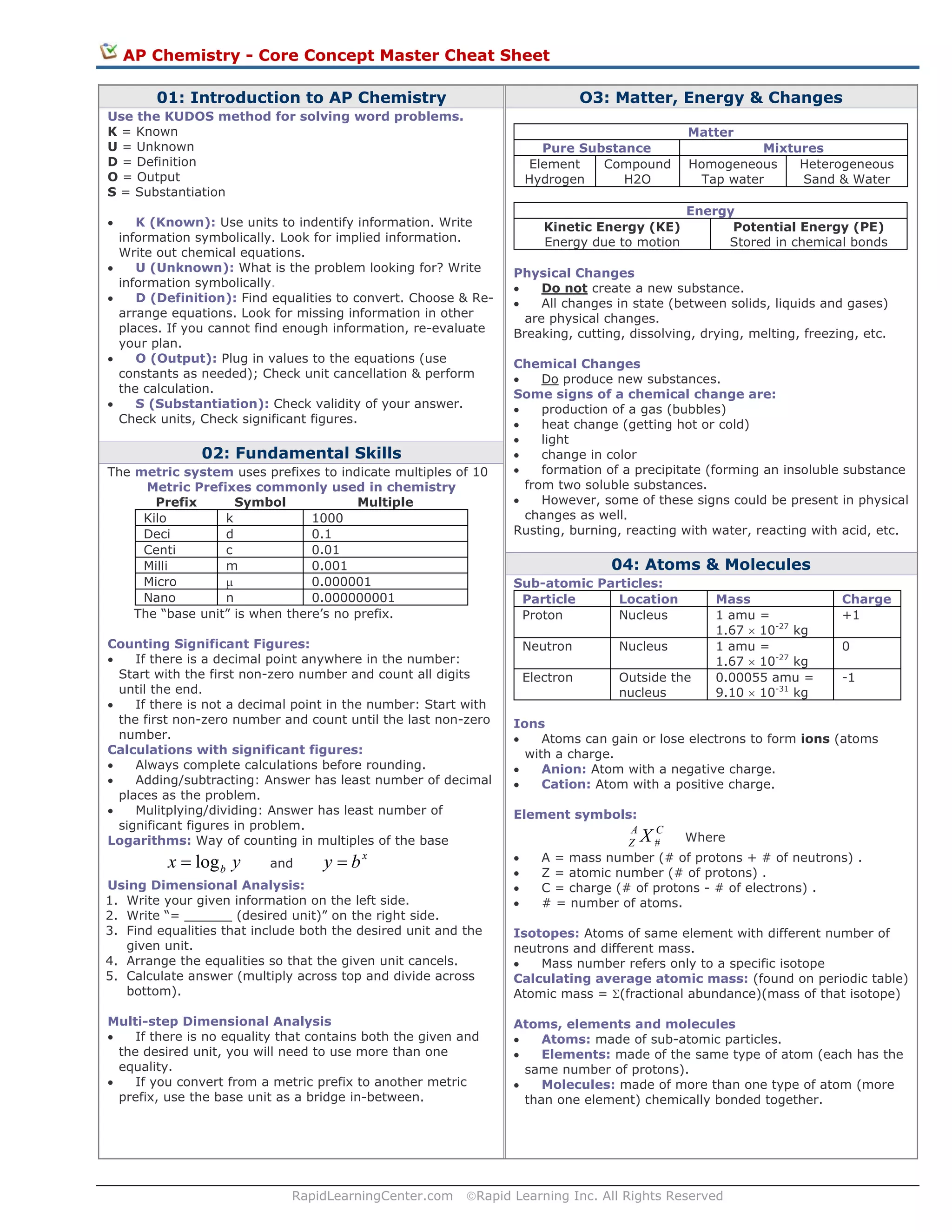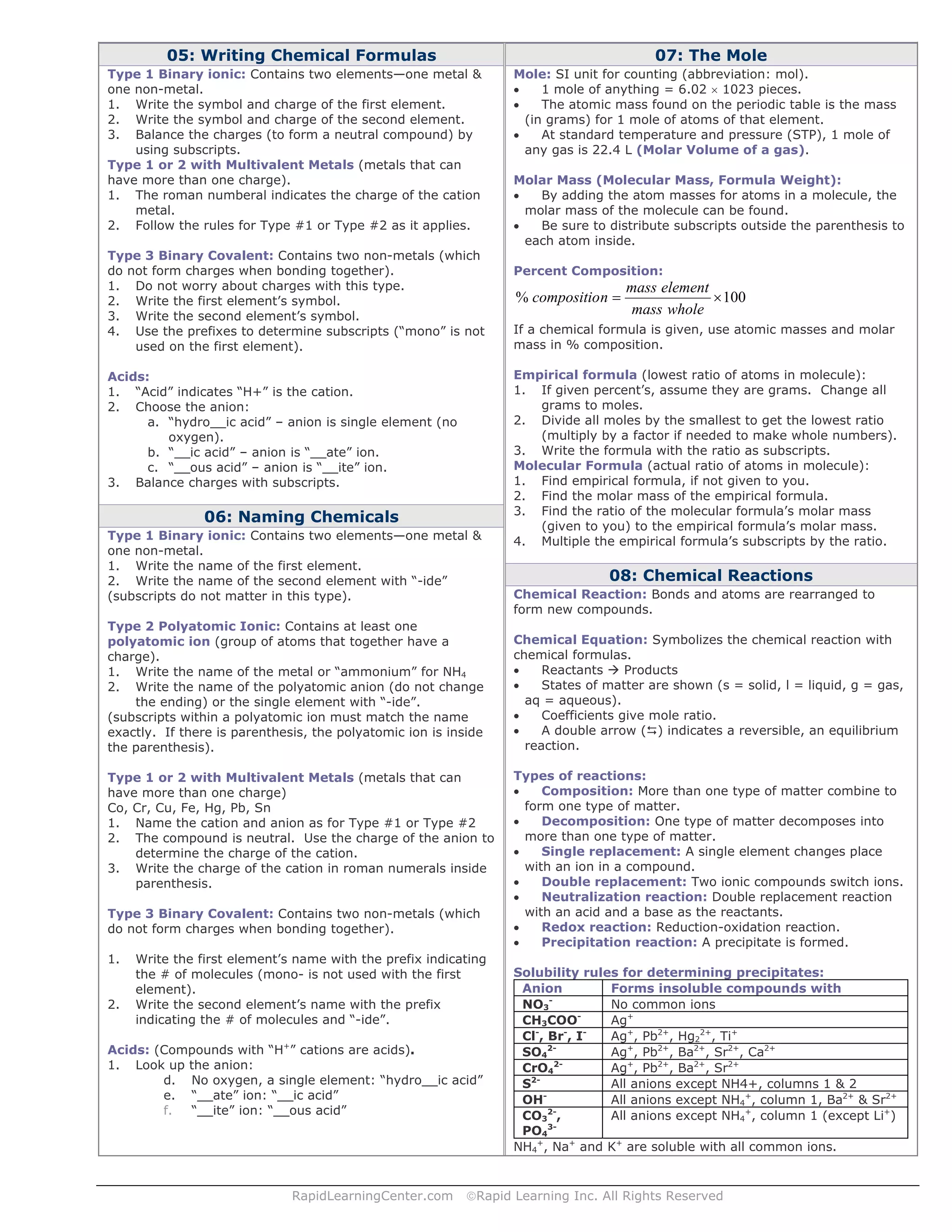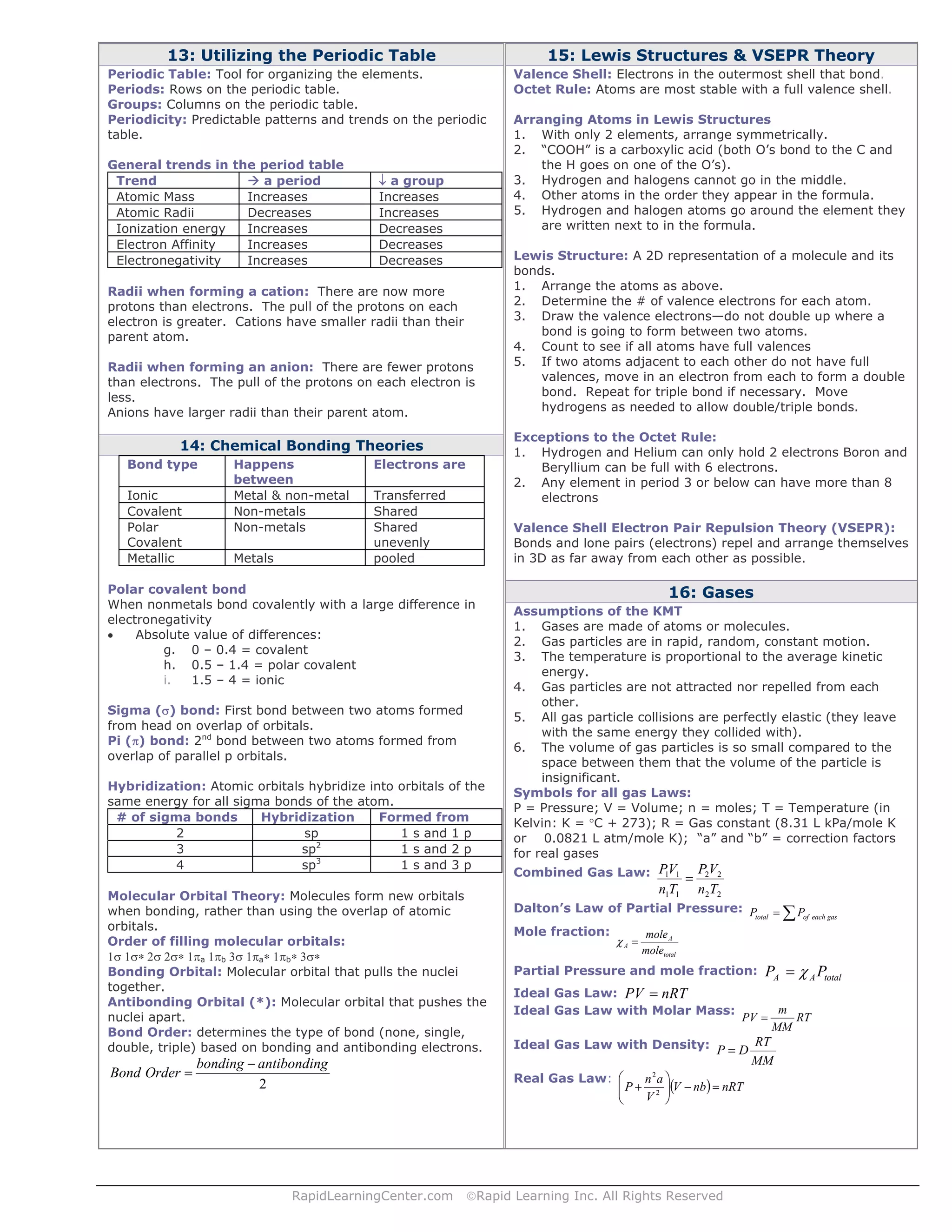The document provides an overview of core concepts in AP Chemistry, including:
1) The KUDOS method is outlined for solving word problems, which involves identifying known and unknown values, definitions, outputs, and substantiating answers.
2) Metric prefixes and significant figures rules are reviewed for calculations involving measurements.
3) Key concepts on matter, energy, and chemical changes are defined, such as the difference between physical and chemical changes.
4) Subatomic particles, ions, isotopes, and the relationship between atoms, elements, and molecules are described.


![RapidLearningCenter.com ©Rapid Learning Inc. All Rights Reserved
09: Balancing Equations
• The Law of Conservation of Mass/Matter requires that a
chemical reaction be balanced.
• Coefficients balance atoms in a chemical reaction and
indicate the number of compounds in a reaction.
Inspection Method (to balance the most simple reactions):
1. Make a list of the elements in the reaction.
2. Count the # of each type of atom on each side.
3. Add coefficients to balance the number of atoms.
4. Determine the total charge of each side and use
coefficients to balance charge.
5. When elements and charge are balanced, place a “1” in
any empty coefficient location.
Oxidation # Method (for simple redox problems):
1. Determine the oxidation numbers of each atom.
2. Determine the net change in charge. Use it to determine
the ratio of atoms that would cancel out the change.
3. Use the ratio as coefficients for the simplest compounds
containing those elements.
4. Finish balancing by the inspection method.
Half-Reaction Method (For the most complex redox
reactions):
1. Use oxidation numbers.
2. Write two half-reactions, 1 for reduction and 1 for
oxidation.
3. Balance all elements except H and O using inspection.
4. For an acid redox reaction: Balance the O’s by adding
H2O to the side needing more O.
5. For a base redox reaction: Balance O by adding twice
as many OH-
to the side needing more O.
6. For an acid redox reaction: Balance the H’s by adding
H+ to the side needing more H’s. For a base redox
reaction: Balance H’s by adding H2O to the side needing
more H’s.
7. Add electrons to balance the charges.
8. Multiply half-reactions by factors cancel out electrons.
9. Add the two half-reactions back together.
10. Cross out anything that appears the same on both sides.
10: Predicting Products
Net Ionic Reactions
1. Separate all aqueous, soluble, ionic compounds into
ions. Only subscripts within polyatomic ions remain—all
other subscripts are changed to coefficients.
2. Cross out all spectator ions.
3. Re-write the equation with remaining ions.
4. The AP Exam will always have “reactions”—all the ions
will never cancel out.
Double replacement—precipitation:
Switch cations with anions of the reactants.
Write the new compounds, balancing charges with subscripts.
Double replacement—acid/base:
Remove the proton from the acid and give it to the base.
Decomposition:
1. Break the reactant into more than one product.
2. Carbonate compounds form CO2 as a product.
Ammonium salts form NH3 as a product.
Composition:
1. Metals and metal oxides added to water make bases.
2. Nonmetals and nonmetal oxides added water make
acids.
Complex Ion Formation:
1. Know the common complex ions on the AP exam:
Ag(CN)2
-1
, Fe(SCN)+2
, Cu(NH4)3
+2
, Zn(NH4)3
+2
,
Ag(NH3)2
+1
, Ni(NH3)6
+2
, Al(OH)4
-1
, Zn(OH)4
-2
Combustion:
1. When hydrocarbons are added to O2, they always
produce CO2 and H2O.
Redox:
1. All single replacement reactions are redox reactions.
2. Other common oxidizers are NO3
-1
, MnO4
-1
, Cr2O7
-2
, and
H2O2.
11: Stoichiometry
Stoichiometry: Using the mole ratio in the balanced equation
and information about one compound to find information
about another in the reaction.
Equalities used during dimensional analysis for
stoichiometry:
• Mole ratio in balanced equation: Use to convert
between moles of different compounds in the balanced
equation.
• Molar mass: Used to convert between grams and moles.
• Concentration: Used to convert between moles and
liters of a solution.
solutionL
solutemoles
Molarity =
• Molar volume of a gas: Used to convert between moles
and liters of a gas at STP.
Limiting reactant: Reactant that stops the reaction by
running out first.
• Once a reactant has run out, the reaction will stop.
• Do stoichiometry for each given reactant quantity to the
same product each time. Choose the calculation that gives
the smallest amount of product.
• The reactant that produced the smallest amount of
product is the limiting reactant.
Percent yield: compares the actual yield to the theoretical
yield.
100% ×=
yieldltheoretica
yieldactual
yield
12: Atomic Structure
Electron cloud: Area outside nucleus where electrons are
located.
Energy levels: Electron cloud is divided into energy levels
for electrons.
Subshells: Energy levels of electrons are divided into
subshells of equal energy orbitals.
Orbitals: Subdivision of subshell. Each orbital can hold 2
electrons.
4 types of subshells:
Subshell Begins
in level
# of
orbitals
# of
electrons
←
higher
energy
s 1 1 2
p 2 3 6
d 3 5 10
f 4 7 14
Aufbau Principle: Fill shells from lowest energy to highest.
Hund’s Rule: electrons are placed in each equal-energy
orbital before doubling up to produce the lowest energy atom.
Pauli Exclusion Principle: Two electrons occupying the
same orbital must be opposite spins (angular momentum).
Use the periodic table as a guide (read left to right):
1s
2s 2p
3s 3p
4s 3d 4p
5s 4d 5p
6s 4f 5d 6p
7s 5f 6d 7p
3 types of electron configuration notation:
Boxes & Arrows: O (8 electrons): 1s ↑↓ 2s ↑↓ 2p ↑↓ ↑ ↑
Spectroscopic: Br (35 electrons):
1s2
2s2
2p6
3s2
3p6
4s2
3d10
4p5
Noble Gas: Br (35 electrons): [Ar] 4s2
3d10
4p5](https://image.slidesharecdn.com/apchemistrymastercheatsheet-140822185511-phpapp01/75/Ap-chemistry-master_cheatsheet-3-2048.jpg)

![RapidLearningCenter.com ©Rapid Learning Inc. All Rights Reserved
17: Liquids & Solids
Intramolecular forces: chemical bonds within a molecule.
Intermolecular forces (IMF): physical attractions between
separate molecules.
• London Dispersion Forces: all molecules, temporary
ganging up of electrons, weakest IMF
• Dipole-Dipole Forces: all polar molecules, medium
strength.
• Ion-Dipole Forces: between a polar molecule and an
ion.
• Hydrogen Bonding: extreme dipole with H on an N, O
or F with another molecule with N, O, or F; strongest IMF.
Amorphous solid particles are “trapped” in place before
they can arrange themselves into a repeating pattern.
Three types of crystalline solids:
• Atomic solids
Metallic solids—closest packing of metal atoms.
Network solids—one giant molecule. Each atom is
covalently bonded to surrounding atoms.
• Molecular solids—strong covalent bonds within the
molecular, weaker physical attractions between them.
• Ionic solids—electrostatic attraction between ions. Ions
are stacked to minimize like-charge repulsions.
Changes in state involve breaking or forming IMF’s
Boiling/Condensation Point: Vapor pressure of liquid =
atmospheric pressure. Liquid and gas at equilibrium
Melting/Freezing Point: Vapor pressure of solid = Vapor
pressure of liquid. Solid and liquid at equilibrium
Melting: fusHmH ×=Δ
Evaporating: vapHmH ×=Δ
18: Solutions
Solution: Homogeneous mixture;
Solute: Substance being dissolved;
Solvent: Substance doing the dissolving
Factors affecting Solubility:
• Pressure: Gases: as Pressure increases, solubility
increases.
• Temperature: Gases: higher temperature is lower
solubility. Most solids: higher temperature is higher
solubility.
Concentration Measurements:
% by mass: 100% ×=
solutionmass
solutemass
mass
Molarity (M):
solutionL
solutemoles
Molarity =
Molality (m):
solventkg
solutemoles
Molality =
Dilution equation: 2211 VMVM =
Electrolyte: compounds dissociate into ions when dissolved
in water. Allows the solution to conduct electricity.
Colligative Property: Property of a solution that depends
on the concentration of the solute particles.
• Van’t Hoff i-factor (i): Factor describing how many
particles is actually in the solution compared to how many
molecules were added.
• Vapor Pressure of a solution is always lower than the
pure solvent.
• Raoult’s Law: AAA PP χ=
Boiling point of a solution is always higher miKT bb =Δ
Freezing point of a solution is always lower than the pure
solvent. miKT ff =Δ
19: Kinetics
Kinetics: Study of reaction rates
In order for a reaction to occur, the molecules must:
Collide with the correct orientation and the Activation
Energy (minimum energy needed for reaction)
Factors affecting rate
• Surface area—as surface area increases, rate increases.
• Concentration—as concentration increases, rate
increases.
• Temperature—as temperature increases, rate increases.
• Catalyst—presence of a catalyst increases rate.
Elementary Step: Chemical equation showing reactants in
one collision and the products formed.
Reaction Mechanism: Series of elementary steps that add
up to the overall reaction.
• k = rate law constant. Is different for each reaction at
each temperature.
• [A] = concentration of reactant
• [A]0 = initial concentration of reactant
• t = time
Rate Laws:
Order Differential Law Integrated Law
0 Rate = k [A] = -kt + [A]0
1 Rate = k[A] ln [A] = -kt + ln [A]0
2 Rate = k[A]2
1 / [A] = kt + 1 / [A]0
Half life (t½): Time for ½ of the original reactants to
disappear. Use integrated rate law and use [A] = ½ [A]0
Calculating EA
A = Arrhenius constant (fraction of collisions with correct
orientation); EA = Activation energy (unit of J/mole);
R = 8.31 J/K×mole; T = temperature (in Kelvin. °C + 273=K)
RT
EA
Aek
−
=
20: Equilibrium
Reversible Reaction: Reaction that goes in both directions.
Equilibrium: When the rate of the forward and reverse of a
reversible process are equal.
Dynamic equilibrium: The number of reactants and
products do not change, but the reaction continues to occur in
both directions.
Writing equilibrium constant expressions
• Concentration of products over concentration of reactants.
• Do not include pure solids or pure liquids.
• Use the coefficients of the balanced equations as powers.
Reaction Quotient (Q): When concentrations at any time
are plugged into the equilibrium constant expression.
• If Q = K, it’s at equilibrium.
• If Q > K, reaction proceeds towards reactants.
• If Q < K, reaction proceeds towards products.
Solubility Product (Ksp): Equilibrium constant for a
dissolution reaction. Written just as any K is.
ICE charts a technique for organizing information in an
equilibrium problem
• Make a table with the reactants and products across top
• Place “ICE” down the left hand side, for Initial, Change
and Equilibrium.
• Fill in any given information from the problem.
• Use the balanced equation’s stoichiometric ratio to
determine the “change” row.
• Use “equilibrium” values to plug in to the K expression.
Le Chatelier’s Principle: A system at equilibrium will re-
adjust to reach equilibrium again when disturbed.](https://image.slidesharecdn.com/apchemistrymastercheatsheet-140822185511-phpapp01/75/Ap-chemistry-master_cheatsheet-5-2048.jpg)
![RapidLearningCenter.com ©Rapid Learning Inc. All Rights Reserved
21: Acids and Bases
• Arrhenius acid: Produces hydronium ion in water.
• Arrehnius base: Produces hydroxide ion in water.
• Hydronium ion: H3O+1
;
• Hydroxide ion: OH-1
Strong acids HCl, HBr, HI, HNO3, HClO3, HClO4
Strong bases NaOH, KOH, Ca(OH)2, Ba(OH)2, Sr(OH)2
For polyprotic acids, each successive proton is weaker than
the one before. (H2SO4 has a strong 1st
hydrogen.
Writing equilibrium constants: Ratio of concentrations of
products to reactants with balanced equation coefficients as
the powers. (Do not include pure solids or liquids.)
baw KKK ×=
]][[ 11
3
−+
= OHOHKw
at 25°C, Kw = 1.0×10-14
The larger the Ka or Kb, the stronger the acid or base
pH: Logarithmic scale of acidity.
]log[ 1
3
+
−= OHpH
pH
OH −+
=10][ 1
3
Solving pH problems
• For strong acids, assume the [H3O+1] = the concentration
of the acid
• For weak acids, use an ICE chart and the Ka for weak acids
(use approximations for tiny Ka’s).
Salt from
• Weak acid + strong base = Basic
• Strong acid + weak base = Acidic
Buffer: Weak acid or base and its conjugate that resists
changes in pH when acid or bases is added
[ ]
[ ]⎟⎟
⎠
⎞
⎜⎜
⎝
⎛
+=
acid
base
pKapH log
where ]log[ aKpKa −=
22: Thermodynamics
Thermodynamics: Study of heat changes.
Energy: The ability to do work or supply heat.
Heat (q): Flow of energy from a hot toward a cooler object.
Enthalpy (H): Takes into account internal energy, pressure
and volume. Same as heat for open-air situations
Work VPw Δ−=
w = work (in J); P = pressure (in atm); ΔV = V2 – V1 (in L)
Specific Heat Capacity (Cp): Amount of energy that 1
gram can absorb before increasing in temperature.
Cp for water: 4.18 J or 1.00 cal
TCmH p Δ××=Δ m = mass; ΔT = T2 – T1
Calorimetry: ΔHsystem = ΔHsurroundings
T2 of both system and surroundings are the same
Enthalpy of formation (Hf): Energy change when a
compound is formed from its elements.
∑∑ −=Δ reactHprodHHrxn ff
Entropy (S): Disorder or random-ness
Free Energy (G): Takes into account enthalpy, entropy and
temperature to determine spontaneity
STHG Δ−Δ=Δ
- ΔG = spontaneous at that temperature
+ ΔG = spontaneous in the opposite direction at that temp
ΔG = 0 at equilibrium
KRTG ln−=Δ and QRTGG ln+Δ=Δ
ΔG° = free energy change at standard state (1 atm and
25°C)
R = 8.31 J/mole×K; T = temperature (in Kelvin); K =
equilibrium constant; Q = Reaction Quotient
23: Electrochemistry
Electrochemistry: The study of the inter-change between
electrical and chemical energy.
Voltaic cell (or Galvanic cell): Uses a redox reaction to
produce electricity.
Electromotive force, EMF (or Cell Potential): Difference of
potential energy of electrons from before and after the
transfer.
Standard reduction potential: EMF if hydrogen is used as
the other half-reaction (Hydrogen is defined as “0”).
Calculating EMF from standard reduction potentials:
EMF = cathode – anode
+ EMF = spontaneous
Stoichiometry & Electrochemistry:
1 amp (A) = 1 Coulomb/sec (C/s)
1 Faraday (F) = 1 mole of e-1
1 Faraday (1 mole of e-1
) = 96475 Coulomb (C)
Free energy = maximum work that can be done by system
EMFFnG ××−=Δ
ΔG = free energy (in J); n = # of moles of electrons
transferred; F = 1 Faraday (1 mole of e-1
) = 96475
Coulomb (C); EMF = cell potential.
Nernst equation: Q
nF
RT
EMFEMF ln−=
EMF = cell potential at current conditions; EMF° = cell
potential at standard state (1 atm & 25°C); R = 8.31
J/mole×K; T = temperature (in Kelvin); n = moles
electrons transferred; F = 1 Faraday; Q = reaction
quotient
RT
EMFFn
K
××
=ln
24: Descriptive & Organic Chemistry
• Descriptive Chemistry: Knowledge of descriptive facts
about chemistry.
• Colorimetry: Study of colored compounds and the
relationship between light absorbed and concentration.
• Organic chemistry: Study of carbon-containing
compounds.
• Hydrocarbon: Compound with hydrogen and carbon atoms.
• Functional Group: Group of atoms on an organic molecule
that affect the properties of that molecule.
• Isomers: Molecules with the same chemical formula but
different structure.
Colored soluble
compounds
Colored insoluble
compounds
Soluble copper salts are
blue/green
AgCl is white
Fe salts are red/brown Chromate precipitates are
orange
Cobalt salts are blue Dichromate precipitates are
yellow
Complex ions are often
colored
Hydroxide precipitates are
white
The most common, simple functional groups:
• Haloalkane: Halogen replacing a hydrogen on the
hydrocarbon.
• Alcohol: “-OH” replacing a hydrogen on the hydrocarbon
• Carboxylic acid: “-COOH” replacing a hydrogen on a
hydrocarbon.
Carbons are counted in the longest chain, starting from the
carbon closest to the functional group.
Prefixes are used to denote number of carbons:
1 = meth-
2 = eth-
3 = prop-
4 = but-
5 = pent-
6 = hex-
7 = hept-
8 = oct-
9 = non-
10 = dec-](https://image.slidesharecdn.com/apchemistrymastercheatsheet-140822185511-phpapp01/75/Ap-chemistry-master_cheatsheet-6-2048.jpg)